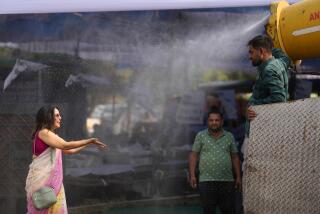Simple Science Could Have Saved Thousands
The astounding tragedy in the Indian Ocean is not just a human disaster of unbearable magnitude. Nor is it a matter of fate. It is the consequence of years of underinvestment in the scientific and technical infrastructure needed to reduce the vulnerability of developing countries to natural and environmental calamity.
Disasters such as this one mobilize relief organizations, and the developed countries offer assistance, compassion and determination in rescue, recovery and reconstruction. But the effect of major disasters extends well beyond the immediate lives lost and buildings damaged. In the aftermath, millions of people will face ongoing problems of lost households, lost livelihoods and well-being, and the ruination of fragile community and social structures. Millions will be at increased risk from disease and starvation.
Such realities mean that years, if not decades, of support will be needed for recovery. And the Earth doesn’t stop turning after one disaster. The region of the Indian Ocean hit by the tsunami is afflicted by typhoons year after year. Some of its resiliency to merely large storms has been washed away.
Those of us who study disasters and their management wonder to what extent the scale of this tragedy would have been lessened had the technologies and scientific capabilities of the developed world been trained on the Indian Ocean and South Asia.
Disasters affect poor and developing countries disproportionately. The poor’s struggle for daily survival does not allow for disaster preparedness. Persistent environmental stress, such as recurring natural disasters, diverts long-term investment in sustainable development. Little is left for the sorts of investments that make for livable societies. When this happens repeatedly, no matter the disaster, countries can get trapped in a reactive rather than proactive development trajectory.
What will motivate the developed world to reduce the effect of disasters before they happen? Should it not be axiomatic that there is a human right to knowledge and technology that can benefit all?
The Sumatra earthquake was no surprise, geologically speaking. And global networks of seismometers operated by the developed world were able to locate the earthquake and quickly characterize its potential to unleash a tsunami, all within a fraction of the time it took for the wave to cross the Bay of Bengal. Agonizingly, despite years of discussions, the relatively inexpensive water level sensors needed to sense and track a tsunami were not in place. Neither was there in place a comprehensive response infrastructure able to use available warnings.
There are no technical barriers to developing a tsunami warning system for the Indian Ocean region. An effective system has been in place in the Pacific for about 40 years. And the civil defense mechanisms in place to evacuate affected areas in the paths of typhoons could have been beefed up to respond more quickly and specifically in the event of a tsunami.
From hurricanes in the Caribbean to earthquakes in Southeast Asia to landslides in the Andes to drought in Africa, we know enough about natural disaster occurrence to identify vulnerable regions. Work by both the United Nations Development Program and the World Bank’s Hazard Management Unit (in which we participated) has quantified the exposures of people and their economies to multiple natural hazards. For the most part, we also know where the potential for devastation is greatest.
Globally, the costs of taking preemptive action are less than what is spent on recovery. The value of saving lives is immeasurable in terms of dollars, of course. In addition, the potential to reduce the ongoing loss of livelihood and well-being has a direct relation to the costs of sustainable development.
Preemptive investments can build strong and long-lasting infrastructure. That means water and sanitation systems, transport and telecommunications networks and healthcare delivery systems. These all are important when it comes to disaster mitigation and response, but they contribute to basic development and living standards as well. Only a fraction of disaster recovery funds gets spent on future mitigation.
The lessons are clear, and the next steps are obvious.
* Map the known exposures of human populations and economic activities to multiple disasters.
* Encourage pilot programs in the most risk-prone areas to demonstrate the practicality of available technology.
* Build indigenous scientific and technical capacity to take advantage of existing technology and allow for local innovation.
* Link developed-world foreign aid to risk-conscious sustainable development.
* Encourage ongoing assessment of disaster risk-management methods.
* Pay for it with development finance mechanisms that provide incentives for preemptive investment in vulnerability reduction.
One measure of a tragedy is how easily it could be avoided. We can begin to reduce the disconnect between what we know and what we do by making relatively small investments, which seem more a matter of human rights than a matter of first-world largess. Scientists find it increasingly urgent to couple learning about our planet and its hazards with directing this knowledge to where it is most needed, particularly to poor communities around the globe.
The developed world -- including countries like the United States that chronically underfund the use of existing science and technology by the poor -- should lead this preemptive war against environmental stress and disaster vulnerability. It is long overdue.






